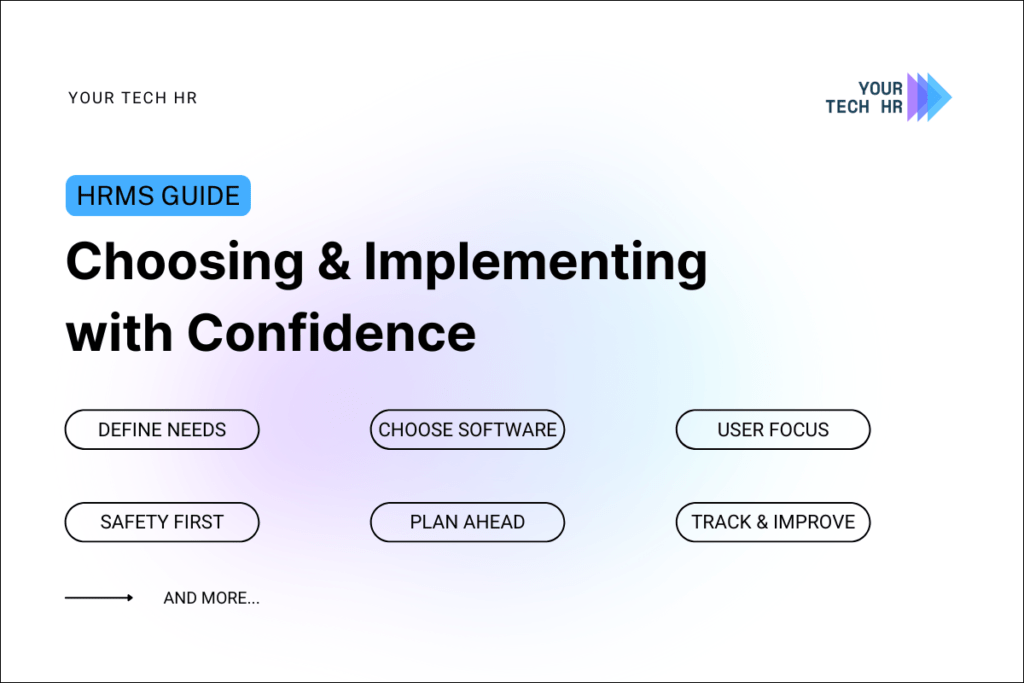Have you ever wondered how some organizations seem to effortlessly manage their workforce, streamline operations, and maintain a high level of employee satisfaction? The secret often lies in selecting and implementing the right Human Resource Management System (HRMS). In today’s fast-paced business environment, a well-chosen HRMS can dramatically enhance efficiency and accuracy. However, selecting the perfect HRMS involves careful consideration from VPs, HR Managers, business experts, and media partners. Understanding your organization’s unique needs and ensuring seamless integration is essential for maximizing your HRMS investment.
In this blog, we’ll uncover best practices for selecting and implementing an HRMS, providing expert insights to guide your decision-making. Get ready to transform your HR operations with YourTechHR drive success with a strategic HRMS approach!
Understanding HRMS Best Practices
Choosing and implementing the right HRMS isn’t just about picking the latest technology; it’s about aligning it with your organization’s needs and goals. Start by defining what you need from the system, be it advanced analytics, seamless integration, or user-friendly interfaces. HRMS Best Practices involves evaluating how well a system meets your specific requirements and aligns with your strategic objectives.
You’re absolutely right! Choosing the right HRMS is a strategic decision that goes beyond just picking the latest tech. Consider factors like scalability, flexibility, and usability and how they impact your HRMS choice:-
- Scalability:-
The ability of an HRMS to handle increasing workloads, data volumes, and user numbers without compromising performance. It’s about ensuring the system can grow with your organization.Why it Matters: As your business expands, you’ll need a system that can accommodate more employees, handle more complex data, and support a wider range of HR functions. A scalable HRMS avoids the need for frequent upgrades or replacements, saving time and resources.
- Flexibility:-
The ability of an HRMS to adapt to changing business needs and processes. This includes customization options, integration capabilities, and the ability to configure workflows.Why it Matters: Businesses are dynamic. Your HR requirements might shift as you implement new programs, adopt different organizational structures, or comply with evolving regulations. A flexible HRMS allows you to adjust the system to meet these changing needs without significant effort or disruption.
- Usability:-
The ease with which users can navigate and interact with the HRMS. This involves intuitive interfaces, clear navigation, and helpful features that simplify HR tasks.
Why it Matters: If your HRMS is difficult to use, it will lead to frustration, errors, and lower adoption rates. A user-friendly system empowers your HR team and employees to use the system effectively, maximizing its benefits.
Key considerations when selecting HRMS software
The selection of HRMS software requires carefu. Key steps include defining requirements, evaluating vendors, ensuring seamless integration, assessing usability, and reviewing costs. Identifying must-have features based on HR processes and company size, choosing vendors with a proven track record and strong customer support, ensuring seamless integration with existing systems, and assessing ongoing maintenance and support costs. These steps help select an HRMS that fits current needs and supports future growth.Below are the 7 best practices for selecting and implementing HRMS software.
- Assess Your Needs and Goals :-
Before diving into the world of HRMS software, it’s essential to assess your organization’s specific needs and goals. What are the weak points in your current HR procedures? Are you looking for features like automated payroll, employee self-service, or robust reporting? A thorough needs assessment helps ensure that you select an HRMS that aligns perfectly with your business objectives. - Evaluate Software Options Thoroughly:-
With so many HRMS options available, evaluating them thoroughly is crucial. Consider factors like usability, scalability, integration capabilities, and customer support. Look for reviews and case studies from companies like yours to see how well the software performs in real-world scenarios. An HRMS that fits your specific needs can significantly enhance HR management practices and drive operational efficiency. - Prioritize User Experience:-
The best HRMS systems are designed with user experience in mind. A user-friendly interface ensures that employees and HR professionals can navigate the system effortlessly. This not only enhances productivity but also encourages adoption across the organization. When evaluating HRMS software, test the user interface to ensure it is intuitive and meets the needs of your team. - Ensure HRMS Compliance and Security:-
Compliance and security are critical considerations when selecting an HRMS. Ensure that the software adheres to relevant legal and regulatory requirements, such as GDPR or HIPAA, depending on your industry. Look for features that help you manage compliance effectively, such as automated updates and audit trails. Security features like data encryption and access controls are essential to protecting sensitive employee information. - Plan for a Smooth Implementation:-
A successful HRMS implementation requires careful planning and execution. Develop a clear implementation plan that includes timelines, resource allocation, and key milestones. Involve all relevant stakeholders in the process and provide comprehensive training to ensure a smooth transition. Effective project management and communication can help minimize disruptions and maximize the benefits of your new HRMS. - Monitor and Optimize Post-Implementation:-
Once your HRMS is up and running, it’s crucial to monitor its performance and make necessary adjustments. Regularly review system reports and user feedback to identify areas for improvement. Continuously optimize your HRMS to adapt to changing business needs and ensure it remains aligned with your goals. This ongoing evaluation helps maintain the effectiveness of your HRMS and supports long-term success. - Leverage Analytics for Strategic Insights:-
Many modern HRMS systems offer powerful analytics capabilities. Use these insights to drive strategic decision-making and enhance your HR practices. Analyzing employee turnover data, performance metrics, and recruitment efficiency can provide valuable information to refine your HR strategies and achieve better outcomes.
Selecting and implementing an HRMS is a strategic decision that can transform your HR operations and drive business success. By following these best hr practices, you can ensure that you choose the right HRMS for your needs and implement it effectively.
Ready to elevate your HR practices and streamline your operations? Contact YouTechHR’s experts today to explore how our solutions can help you achieve your goals and drive your business forward.
7. How do I choose between different HRMS options?
Evaluate HRMS options based on features, scalability, integration capabilities, user experience, and customer support. Consider reviews and case studies to gauge real-world performance.

